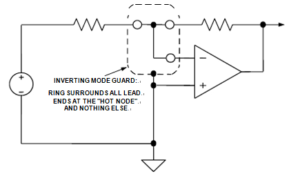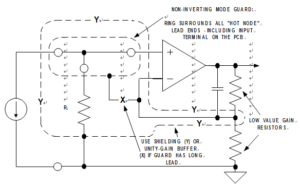Static PCB Board Effect in PCB Manufacturing
If a circuit displays sensitivity to Electrical Leakage in PCB Manufacturing, even the most rigorous cleaning can offer only a temporary solution. Problems soon return upon handling, or exposure to foul atmospheres, and high humidity. Some additional means must be sought to stabilize circuit behavior, such as conformal surface coating.
Fortunately, there is an answer to this, namely guarding, which offers a fairly reliable and permanent solution to the problem of surface leakage. Well-designed guards can eliminate leakage problems, even for circuits exposed to harsh industrial environments. Two schematics illustrate the basic guarding principle, as applied to typical inverting and noninverting op amp circuits.
Below Figure illustrates an inverting mode guard application. In this case, the op amp reference input is grounded, so the guard is a grounded ring surrounding all leads to the inverting input, as noted by the dotted line.

Inverting Mode Guard Encloses All Op Amp Inverting Input Connections Within a Grounded Guard Ring
Guarding basic principles are simple: Completely surround sensitive nodes with conductors that can readily sink stray currents, and maintain the guard conductors at the exact potential of the sensitive node (as otherwise the guard will serve as a leakage source rather than a leakage sink). For example, to keep leakage into a node below 1 pA (assuming 1000-megohm leakage resistance) the guard and guarded node must be within 1 mV. Generally, the low offset of a modern op amp is sufficient to meet this criterion.

Noninverting Mode Guard Encloses all Op Amp Noninverting Input Connections Within a Low Impedance, Driven Guard Ring






